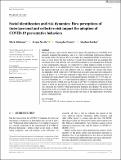Files in this item
Social identification and risk dynamics : how perceptions of (inter)personal and collective risk impact the adoption of COVID-19 preventative behaviors
Item metadata
| dc.contributor.author | Atkinson, Mark | |
| dc.contributor.author | Neville, Fergus G. | |
| dc.contributor.author | Ntontis, Evangelos | |
| dc.contributor.author | Reicher, Stephen David | |
| dc.date.accessioned | 2023-05-04T09:30:09Z | |
| dc.date.available | 2023-05-04T09:30:09Z | |
| dc.date.issued | 2024-01-24 | |
| dc.identifier | 284271542 | |
| dc.identifier | 8790e0eb-e309-46c1-89f2-21b83dc497df | |
| dc.identifier | 85158133421 | |
| dc.identifier.citation | Atkinson , M , Neville , F G , Ntontis , E & Reicher , S D 2024 , ' Social identification and risk dynamics : how perceptions of (inter)personal and collective risk impact the adoption of COVID-19 preventative behaviors ' , Risk Analysis , vol. 44 , no. 2 , pp. 322-332 . https://doi.org/10.1111/risa.14155 | en |
| dc.identifier.issn | 1539-6924 | |
| dc.identifier.other | ORCID: /0000-0001-7377-4507/work/134491804 | |
| dc.identifier.uri | https://hdl.handle.net/10023/27507 | |
| dc.description | Funding: This work was supported by the UK Research and Innovation/Economic and Social Research Council (grant reference number ES/V005383/1). | en |
| dc.description.abstract | Public adoption of preventative behaviors to reduce the transmission of COVID-19 is crucial to managing the pandemic, and so it is vital to determine what factors influence the uptake of those behaviors. Previous studies have identified COVID-19 risk perceptions as a key factor, but this work has typically been limited both in assuming that risk means risk to the personal self, and in being reliant on self-reported data. Drawing on the social identity approach, we conducted two online studies in which we investigated the effects of two different types of risk on preventative measure taking: risk to the personal self and risk to the collective self (i.e., members of a group with which one identifies). Both studies involved behavioral measures using innovative interactive tasks. In Study 1 (n = 199; data collected 27 May 2021), we investigated the effects of (inter)personal and collective risk on physical distancing. In Study 2 (n = 553; data collected 20 September 2021), we investigated the effects of (inter)personal and collective risk on the speed at which tests are booked as COVID-19 symptoms develop. In both studies, we find that perceptions of collective risk, but not perceptions of (inter)personal risk, influence the extent to which preventative measures are adopted. We discuss the implications both conceptually (as they relate to both the conceptualization of risk and social identity processes) and also practically (in terms of the implications for public health communications). | |
| dc.format.extent | 11 | |
| dc.format.extent | 1396068 | |
| dc.language.iso | eng | |
| dc.relation.ispartof | Risk Analysis | en |
| dc.subject | COVID-19 | en |
| dc.subject | Pandemic | en |
| dc.subject | Personal risk | en |
| dc.subject | Collective risk | en |
| dc.subject | Preventative measures | en |
| dc.subject | BF Psychology | en |
| dc.subject | E-NDAS | en |
| dc.subject | SDG 3 - Good Health and Well-being | en |
| dc.subject.lcc | BF | en |
| dc.title | Social identification and risk dynamics : how perceptions of (inter)personal and collective risk impact the adoption of COVID-19 preventative behaviors | en |
| dc.type | Journal article | en |
| dc.contributor.institution | University of St Andrews. School of Management | en |
| dc.contributor.institution | University of St Andrews. School of Psychology and Neuroscience | en |
| dc.identifier.doi | 10.1111/risa.14155 | |
| dc.description.status | Peer reviewed | en |
This item appears in the following Collection(s)
Items in the St Andrews Research Repository are protected by copyright, with all rights reserved, unless otherwise indicated.

